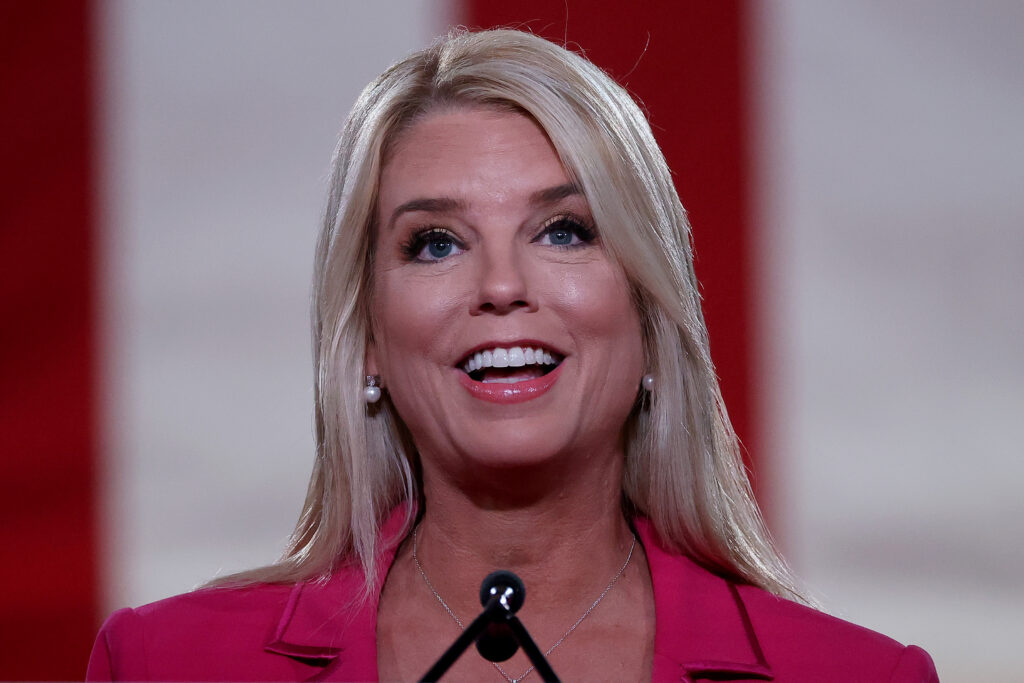
Former Florida Attorney General Pam Bondi address the Republican National Convention on Aug. 25, 2020 in Washington, D.C. (Chip Somodevilla/Getty Images).
Donald Trump announced that loyalist Pam Bondi is his pick for the next U.S. Attorney General.
From 2011 to 2019, Bondi served as the Attorney General of Florida. In early 2020, Bondi was one of then-President Donald Trump’s defense lawyers during his first impeachment trial. Later that year, Bondi repeated unsubstantiated claims by Trump that there had been widespread voter fraud in the 2020 presidential election.
Trump’s pivot from a scandal-plagued Matt Gaetz to Bondi has drawn both praise and criticism. Republican Sen. Lindsey Graham, a Trump ally, called Bondi “a grand slam, touchdown, hole in one, ace, hat trick, slam dunk, Olympic gold medal pick.”
In contrast, in reference to Bondi’s efforts to undermine the 2020 election, Randall Eliason, a former assistant U.S. attorney, said he felt “being an election denier should be disqualifying for anyone to be attorney general.”
Be that as it may, the U.S. attorney general not elected, but selected, and Bondi is the person that Trump has selected for this important role.
Interestingly, the U.S. Constitution makes no mention of attorneys general, who today administer justice by overseeing more than 115,000 federal employees in approximately 40 separate component organizations, including the Federal Bureau of Investigation and the Federal Bureau of Prisons.
Congress created the position with the Judiciary Act of 1789, which is the same act that organized the U.S. Supreme Court. This connection may indicate that the founders intended for the attorney general to be a part of the judicial branch. Indeed, original drafts of the Judiciary Act empowered the Supreme Court to select the attorney general rather than the president.
Due to disagreements among the founders, the specifics of the attorney general selection process ended up being entirely omitted from the final version of the Judiciary Act. This provided an opening for the first president, George Washington, to fill that void by assuming the power to nominate the attorney general, then asking for Senate approval. This process has since become the norm.
Nevertheless, in his writings, Thomas Jefferson referred to this new position as the, “Attorney General for the Supreme Court.”
Moreover, early attorneys general shared both offices and budgets with the judicial branch as opposed to the executive branch. The Justice Department was established in 1870, and the attorney general was designated as its head, thereby codifying the position’s place within the executive branch.
How Eric Greitens and Josh Hawley soared so quickly in Missouri politics
If confirmed, Bondi will not be the first loyalist to serve as attorney general, and such appointments are not unique to Republican presidents.
Eric Holder, the first attorney general Barrack Obama appointed, publicly proclaimed to be the president’s “wingman.” Holder ended up becoming the first attorney general to be held in both criminal and civil contempt of Congress for failing to turn over documents related to the “Fast and Furious” scandal after Obama asserted executive privilege over said documents.
Other examples of cronyism include President John F. Kennedy who appointed his 35-year-old younger brother, Robert, as attorney general, despite questionable qualifications. A few decades prior, President Harry S Truman appointed his former campaign manager to the role. This trend arguably goes as far back as George Washington, who chose his former personal assistant, Edmund Jennings Randolph, as the country’s first attorney general.
At the state level, it is unusual for the governor to select the attorney general. Only five states grant the governor such power: Alaska, Hawaii, New Jersey, New Hampshire and Wyoming.
In Maine, originally the governor appointed the attorney general, but since 1855, the attorney general has been chosen by the state legislature. In Tennessee, the attorney general is chosen by the state Supreme Court and is considered to be an officer of the judicial branch rather than the executive branch.
In the remaining 43 states, the attorney general is elected to the office.
In such states, attorneys general answer to voters, not the governor, and the governor cannot fire or otherwise replace an attorney general that he or she disagrees with. As a result, an elected state attorney general has a freer hand to disagree with the governor — even when they are from the same party.
For instance, back in 2018, then-Missouri Gov. Eric Greitens admitted to having an extramarital affair and was subsequently investigated for blackmail and assault. After a bipartisan report was released by the Missouri House Special Investigative Committee on Oversight which detailed graphic allegations against Greitens, then-Attorney General Josh Hawley called for Greitens to “resign immediately,” which he ended up doing a little over a month later.
At the federal level, presidents not only have the power to hire loyalists, but they also have the power to dismiss any attorneys general deemed to be insufficiently loyal. For example, Trump has admitted to firing his first attorney general, Jeff Session, for failing to “end the phony Russia Witch Hunt.”
In his appointment of Bondi, it appears that Trump seeks an attorney general more receptive to presidential influence. This could be because Trump views the president, not the attorney general, as “the chief law enforcement officer of the country.” In the past, Trump has gone so far as to claim that presidents have the right to do whatever they want.
Any proposal to change how the U.S. attorney general is appointed so that the process is more in line with how most states operate would face many hurdles. However, the implementation of such a change might better ensure that future presidents have greater respect for the law.

